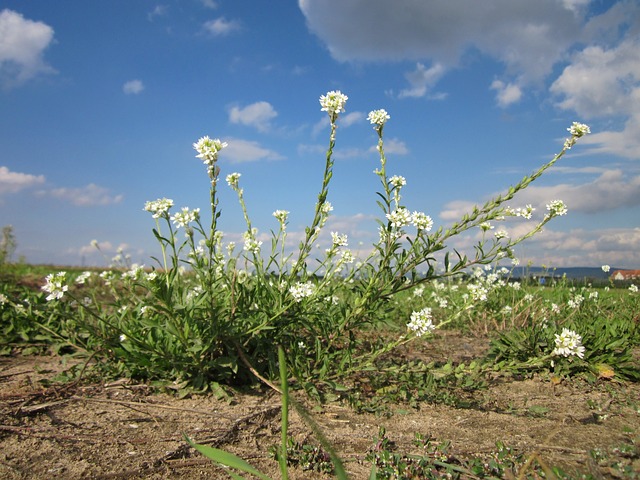 |  |  |  |  |
 |  |  |
Hoary Alison is usually a biennial plant, rarely annual or perennial. The plant has a developed tap root system.
Single stem, erect, 30-80 cm tall, rarely up to 1 m. Continuously covered with leaves, often with a brown tint. The stem branches at the top. Often several stems form from one root.
The pages are arranged alternately. Rhizome leaves on short petioles, stem leaves sessile. The leaf blade is lanceolate, grows up to 8-10 cm, the edge of the leaf is smooth. The vegetative parts of the plant are hairy, which gives the plant a greyish-green hue. The hairs help the plant retain moisture in hot weather.
The inflorescence is located at the top of the plant. The actinomorphic flower grows up to 1 cm in diameter. The flower consists of four white-green sepals and four small (~5mm), white petals, which are deeply split at the ends (the petal resembles bunny ears). This split is so pronounced that it may seem that the Hoary Alison flower consists of 8 petals.
Under the conditions of sufficient moisture and sun, the Hoary Alison blooms from early spring to late autumn (usually from May to September), and the flowers look untwisted throughout the flowering period. This illusion occurs in the specific mechanism of flower opening. Initially, the marginal and some central flowers open in the inflorescence. Then the flowers fall off and begin to form a seed, in turn, the inflorescence grows longer and forms new flowers and blooms again. And this is how a seeming illusion arises that the plant blooms all the time and does not wither.
Pollination is provided by small insects - flies, wild bees and wasps.
The fruits are elliptical pods, which are directed upwards, up to 1 cm in length. Each pod contains 4-12 dark red-brown, tiny seeds. Inside, the fruit is divided into two parts, in the middle there is a transparent, separating lobe, which remains even after the seeds have been shed. Seed germination lasts up to 9 years.
Hoary Alison reproduces only with the help of seeds. They can germinate from early spring to late autumn, just enough water is needed. Plants that germinate in the spring produce seeds already in the fall, but plants that germinate only in the summer or fall overwinter and produce seeds the following year. According to this growth pattern, the plant is often classified as a biennial. Late plants accumulate a large amount of sugar in the roots, which allows it to overwinter.
The above-ground part of the plant is used for medicinal purposes. Harvesting is done during the flowering period of the plant. The collected plants are usually shortened and dried on sieves in a well-ventilated and shaded place. Drying can also be done in forced dryers, not exceeding a temperature of 40C.
The drug is stored in a breathable container for no longer than one year.
The chemical composition of Hoary Alison has been little studied. However, the plant is known to contain alkaloids, coumarins, cardenolides, flavonoids, tannins, ascorbic acid and organic acids, and the glycoside synergine. In addition, the plant contains quite a lot of macro and micro elements, including zinc, rubidium and strontium.
You should know that the amount of zinc in the plant exceeds the permissible concentration ten times.
Medicinal significance
The hypotensive effect from the use of Hoary Alison is justified by the alkaloids present in the plant, which have a vasodilating and calming effect.
Acids such as formic acid, acetic acid, citric acid and others contained in the plant have a beneficial effect on digestive processes, as well as the microflora of the intestinal tract. Tannins have an astringent effect in case of intestinal tract disorders.
The plant also contains coumarins, which help relax the nervous system and relieve headaches.
In folk medicine, extracts and decoctions of Hoary Alison are used for the treatment of nervousness, shortness of breath and cough, headaches, convulsions, digestive tract and uterine bleeding.
Hoary Alison has a diaphoretic, diuretic, analgesic and anti-inflammatory effect.
Baths of a decoction of Hoary Alison are effective against emaciation and convulsions, in children, in the first years of their life (spasmophilia).
Sometimes, only certain parts of the plant - flowers, seeds, leaves with stems - are used to prepare the infusion/decoction.
